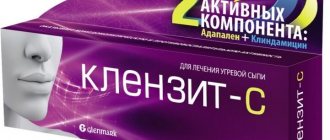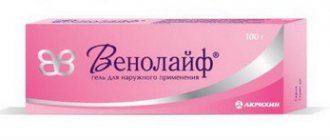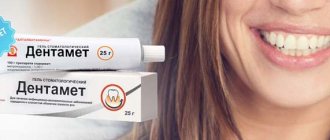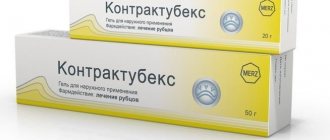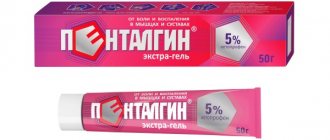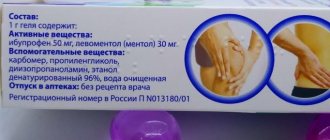Drug interactions
When ketoprofen is used simultaneously with other NSAIDs, the risk of developing erosive and ulcerative lesions of the gastrointestinal tract and bleeding increases;
with antihypertensive drugs - their effect may be reduced; with thrombolytics - increased risk of bleeding. When used together with diuretics, the risk of developing renal failure increases due to a decrease in renal blood flow caused by inhibition of prostaglandin synthesis and against the background of hypovolemia.
When used in combination with acetylsalicylic acid, it is possible to reduce the binding of ketoprofen to plasma proteins and increase its plasma clearance; with heparin, ticlopidine - increased risk of bleeding; with lithium preparations - it is possible to increase the concentration of lithium in the blood plasma to toxic levels due to a decrease in its renal excretion.
With the simultaneous use of warfarin, severe, sometimes fatal bleeding may develop.
When used simultaneously with probenecid, the clearance of ketoprofen and its binding to plasma proteins may be reduced; with methotrexate – the side effects of methotrexate may increase.
Interaction of Flexen with other drugs
Flexen enhances the effect of: antiplatelet agents, anticoagulants, fibrinolytics, estrogens, ethanol, and also enhances the side effects of mineralocorticosteroids and glucocorticosteroids. Weakens the effect of antihypertensive drugs.
Simultaneous use of Flexenas with analogues from the group of non-hormonal anti-inflammatory drugs, as well as ethanol, glucocorticosteroids and corticotropin, can cause the formation of ulcers, gastrointestinal bleeding and increase the risk of developing kidney dysfunction.
Reviews of Flexen therapy in combination with oral anticoagulants, antiplatelet agents, thrombolytics, heparin, cefoperazone, cefatetan and cefamandole showed the possible development of bleeding.
Combination with sodium valproate may cause platelet aggregation disorders.
Flexen's hematotoxicity is enhanced by myelotoxic agents.
Patients combining Flexen with warfarin, lithium salts or coumarin anticoagulants should be under medical supervision.
Particular caution must be exercised when prescribing Flexen analogues to patients with peptic ulcer disease, liver and kidney failure. According to the instructions, Flexen is prohibited from being combined with alcoholic beverages.
Persons doing work that requires concentration, including driving, should exercise special caution while taking Flexen.
Gel Flexen composition
100 g of gel contain: Active substance: ketoprofen - 2.5 g.
Excipients: ethanol 96% - 32 g, glycerol - 3 g, carboxypolymethylene - 2 g, diethanolamine - 2 g, methyl parahydroxybenzoate - 0.06 g, propyl parahydroxybenzoate - 0.032 g, purified water - 58.408 g.
Description Homogeneous transparent colorless gel. The gel should be free from clots and agglomerates and be easily distributed on a glass plate.
Pharmacotherapeutic group: Non-steroidal anti-inflammatory drug (NSAID).
ATX code: M02AA10.
Pharmacological properties FLEXEN has local analgesic, anti-inflammatory and anti-edematous effects. In the form of a gel, it provides a local therapeutic effect on affected joints, tendons, ligaments and muscles. In case of articular syndrome, it causes a decrease in joint pain at rest and during movement, a decrease in morning stiffness and swelling of the joints.
Pharmacokinetics: When applied cutaneously, it is absorbed slowly. Practically does not accumulate in the body. The bioavailability of the gel is about 5%.
Pharmacological action[edit | edit code]
The active substance ketoprofen belongs to the group of non-steroidal anti-inflammatory drugs (NSAIDs) with a pronounced analgesic and anti-inflammatory effect.
Flexen has a pronounced analgesic, anti-inflammatory and antipyretic effect, suppresses platelet aggregation. Flexen inhibits the synthesis of prostaglandins, leukotrienes and thromboxanes.
Flexen has a dual analgesic effect: peripheral - suppression of prostaglandin synthesis; central - blocking the central component at the level of the spinal cord and supraspinal structures.
The analgesic effect develops in the first days of treatment.
Flexen relieves joint pain during movement and at rest, reduces morning stiffness and swelling of joints, and helps increase range of motion.
Pharmacokinetics[edit | edit code]
Suction. Ketoprofen is quickly and fully absorbed when administered intramuscularly, orally and rectally. The maximum concentration of the drug in the blood plasma is achieved: when administered orally after 60-90 minutes, when administered rectally after 45-60 minutes, when administered intramuscularly after 20-30 minutes. The bioavailability of the gel is about 5%, which allows you to achieve a local effect without a pronounced systemic effect.
Distribution. Flexen's binding to plasma proteins is 90%. The drug is able to quickly penetrate the blood-brain barrier (15 minutes after injection). It penetrates well into connective tissue and synovial fluid, where its concentration 4 hours after administration exceeds that in plasma and persists for a longer period (up to 30 hours).
Excretion. Flexen is eliminated mainly by renal excretion and, to a lesser extent, through the intestines. The half-life of the drug from plasma is: after taking capsules 1.5-2 hours, after administering suppositories about 2 hours, after intramuscular administration 1.3 hours. No accumulation effect is observed.
Flexen belongs to the group of short-lived drugs, which is a favorable factor when prescribed to athletes.
Indications for use[edit | edit code]
- Relief of pain due to contusion, displacement and sprain of muscles, ligaments, bruises.
- Treatment of chronic pain syndrome of moderate intensity.
- Symptomatic and pathogenetic treatment of inflammatory and inflammatory-degenerative diseases of the joints: nonspecific spondyloarthritis, osteoarthritis, as well as rheumatic diseases of extra-articular tissues (pain in the neck, shoulder and upper extremities, pain in the lower back and sciatica, bursitis, tendonitis and tenosynovitis, fibromyalgia) .
- Phlebitis, superficial thrombophlebitis, lymphangitis.
- Treatment of intense pain in combination with opioids to reduce the dose of the latter.
Method of administration and dosage[edit | edit code]
You can use a single dosage form or combine different dosage forms for more effective treatment. In this case, the daily dose (excluding the gel, which has only a local effect) should not exceed 300 mg.
Dosing options. Capsules - 1 capsule 3 times a day. Gel - morning, afternoon, evening - gently rubbed into inflamed or painful areas of the body or injected by electrophoresis.
Contraindications[edit | edit code]
For oral administration: erosive and ulcerative lesions of the gastrointestinal tract in the acute phase; “aspirin” asthma; severe liver or kidney dysfunction; pregnancy and lactation; hypersensitivity to ketoprofen and salicylates.
For external use: weeping dermatoses, eczema, infected abrasions, wounds.
Side effects[edit | edit code]
When using therapeutic doses of the drug, undesirable effects occur rarely and are temporary. With prolonged use, dyspeptic symptoms, pain in the epigastric region, severe headache, dizziness and allergic reactions are possible.
Special instructions[edit | edit code]
When prescribed simultaneously with anticoagulants, the risk of bleeding increases.
Flexen side effects
When using the drug FLEXEN, allergic reactions from the skin may be observed: skin hyperemia, itching, urticaria, contact eczema, photosensitivity, very rarely - exfoliative dermatitis, Stevens-Johnson syndrome and toxic epidermal necrolysis; anaphylactic reactions, broncho-obstructive syndrome.
If any side effects occur, you should stop using the drug and consult a doctor.
Overdose The extremely low systemic absorption of the active components of the drug when used externally makes overdose almost impossible.
The possibility of overdose cannot be ruled out due to accidental ingestion of large quantities of the drug.
Interaction with other drugs You should consult your doctor before using the drug if you are under medical supervision or using other NSAIDs.
Ketoprofen may enhance the effect of drugs that cause photosensitivity. Clinically significant interactions with other drugs have not been described.
Special instructions Avoid getting the gel on damaged skin surfaces, open wounds, eyes and other mucous membranes. To avoid manifestations of hypersensitivity and photosensitivity, it is recommended to avoid exposure of the skin to sunlight (even in cloudy conditions) or UV radiation in a solarium during the course of treatment and two weeks after treatment.
The drug contains ethanol, this should be taken into account when using it in athletes. Wash your hands thoroughly after each use of the drug. Do not use occlusive dressings.
When using the drug in large doses with a long course of treatment, systemic side effects may occur.
Release form Gel for external use 2.5%. 30 g or 50 g in an aluminum tube with a protective membrane for the first opening, sealed with a polyethylene screw cap. Tube along with instructions for use in a cardboard box.
Photo of a tube of flexen gel 30 g
Storage conditions Store at a temperature not exceeding 25 °C. Keep out of the reach of children.
Shelf life: 3 years. The drug should not be used after the expiration date!
Photo of the packaging of flexen gel 30 g, where the expiration date is indicated
Dispensing conditions Without a prescription.
Manufacturer: Lizapharma S.pA, Italy. Via Licinio, 11 Erba (SO).
Company holding the registration certificate: Italfarmaco S.p.A., Italy 20126, Milan, Viale Fulvio Testi, 330
Photo of Flexen gel 30 g packaging, where the manufacturer is indicated
Lyophilisate for the preparation of injection solution Flexen
Instructions for medical use of the drug
Description of pharmacological action
NSAID, propionic acid derivative. It has analgesic, anti-inflammatory and antipyretic effects. The mechanism of action is associated with inhibition of the activity of COX, the main enzyme in the metabolism of arachidonic acid, which is a precursor of prostaglandins, which play a major role in the pathogenesis of inflammation, pain and fever. The pronounced analgesic effect of ketoprofen is due to two mechanisms: peripheral (indirectly, through suppression of prostaglandin synthesis) and central (due to inhibition of prostaglandin synthesis in the central and peripheral nervous system, as well as the effect on the biological activity of other neurotropic substances that play a key role in the release of pain mediators in the spinal cord). brain). In addition, ketoprofen has antibradykinin activity, stabilizes lysosomal membranes, and causes significant inhibition of neutrophil activity in patients with rheumatoid arthritis. Suppresses platelet aggregation.
Indications for use
Inflammatory diseases of the musculoskeletal system: osteoarthritis, ankylosing spondylitis, gout, rheumatoid arthritis, bursitis, tenosynovitis, sciatica, myalgia, radiculitis, bruises and sprains of muscles, tendons and ligaments, edema (symptomatic therapy); pain syndrome (postoperative, post-traumatic pain, pain with bone metastases), renal colic, algodismenorrhea. Solution for injection - acute pain syndrome.
Release form
lyophilisate for preparing rosemary for internal lingual administration 100 mg; dark glass ampoule with retailer in ampoules, plastic pallet 6, cardboard pack 1; lyophilisate for preparing rosemary for internal lingual administration 100 mg; ampoule with retailer in ampoules, cardboard pack 6; Warehouse 1 soft gelatin capsule containing ketoprofen 50 mg; 10 pcs in a blister, 3 blisters in a cardboard package. 1 rectal suppository - 100 mg; There are 6 strips per strip, 2 strips in a cardboard package. 100 g gel - 2.5 g; in tubes of 30 or 50 g, in a cardboard package 1 tube. 1 ampoule with lyophilized powder for preparing injections - 100 mg, complete with ampoules; There are 6 sets in a cardboard package.
Pharmacodynamics
NPZD, similar to propionic acid. It exhibits analgesic, antipyretic and antipyretic effects. The mechanism of action is related to the suppression of the activity of COX - the main enzyme in the metabolism of arachidonic acid, which is a precursor of prostaglandins, which play a major role in the pathogenesis of inflammation, pain and loss. The analgesic effect of ketoprofen is expressed by two mechanisms: peripheral (indirectly, through inhibition of prostaglandin synthesis) and central (by inhibiting the synthesis of prostaglandins in the central and peripheral nervous systems, I also influence the biological activity of other neurotropic substances that play a key role in the neurotransmitter of pain in spinal cord). In addition, ketoprofen has anti-bradykinin activity, stabilizes the lysosomal membrane, and increases the importance of galvanizing the activity of neutrophils in patients with rheumatoid arthritis. Suppresses platelet aggregation.
Pharmacokinetics
Data on the pharmacokinetics of the drug Flexen are not available.
Use during pregnancy
Contraindicated. For an hour of rejoicing, follow the instructions for breastfeeding.
Contraindications for use
Hypersensitivity (including other NSAIDs), illness of the thyroid gland in the acute phase, manifestations of impaired liver function, leukopenia, thrombocytopenia, impaired pharyngitis, hemorrhoids and proctitis (suppositories), vaginal Ethnicity, breastfeeding, childhood up to 15 years of age .
Side effects
Side effects of the nervous system and organs include: confusion, headache, asthenia. On the side of the GCT organs: gastralgia, boredom, vomiting, diarrhea, flatulence, scolial-intestinal hemorrhages. Others: transient dysuria, skin allergic reactions (severbizh, kropivyanka), with frozen suppositories - liver pain, tenesmus, rare stelec.
Directions for use and doses
Capsules: first, afterward, uneaten and washed down with plenty of water, 50-100 mg 2-3 times per dose. Suppositories: rectally, 1 soup. (100 mg) 1-2 times per dose. Gel: locally, apply a small amount of gel with a thin ball onto the skin above the burnt spot and rub lightly 2-3 times. The pain of treatment does not need to last 14 days without consulting a doctor. Injections: 100 mg orally, 1-2 times a day for several days. After relief from acute pain syndrome, switch to capsules or suppositories. The maximum dosage is 300 mg.
Precautions for use
Caution is taken in patients with impaired liver function or liver function, a history of thyroid disease, bronchial asthma, rhinitis, urticaria, polyps of the nasal mucosa, heart failure and elderly people. Avoid spreading the gel onto the damaged surface of the skin, open wounds, eyes and other mucous membranes.
Storage conditions
List B.: At a temperature not exceeding 25 ° C.
Best before date
36 months
ATX classification:
M Musculoskeletal system
M01 Anti-inflammatory and antirheumatic drugs
M01A Non-steroidal anti-inflammatory drugs
M01AE Propionic acid derivatives
M01AE03 Ketoprofen
Flexen gel analogues
Often, when prescribing a particular drug, the consumer tries to find its analogue. What is it for? In most cases, a person has a single goal - saving. By choosing a substitute, the patient can spend less. However, such success does not always really bear fruit. Often, substitutes for one or another remedy are simply ineffective. Therefore, in order not to find yourself in a similar situation, you should definitely consult with doctors before choosing a drug.
The medicine "Flexen" (gel), like many other medicines, has its substitutes. When selecting an analogue, the composition of the prescribed medicine is always taken into account. Absolute substitutes for a drug are considered to be those drugs that contain the same active substance. These include “Fastum-gel”, “Ketoprofen”, “Ketonal”, “Febrofid”, “Artrosilene”. The most inexpensive of the listed products can be considered Ketoprofen gel. When purchasing it, you will need to pay no more than 60 rubles. Whereas the original Flexen product costs at least 200. It is worth saying that there are even more expensive analogues of the drug.
Read also[edit | edit code]
- Anestezin
- Apizartron
- Arnica
- Ben gay
- Butadion
- Venoruton
- Viprosal
- Virapin
- Voltaren
- Heparinoids
- Heparin ointment
- Hepatrombin
- Diclofenac
- Dimexide
- Ibuprofen
- Indovazin
- Iruksol
- Ketorol
- Lyoton gel
- Menthol
- Formic alcohol
- Nicoflex
- Nimesulide
- Novocaine
- Panthenol
- Piroxicam
- Plantain
- Propolis
- Bee venom
- Rosemary oil
- Chamomile
- Troxevasin
- Fastum gel
- Capsicum tincture
- Fluorocort
- Chloroethyl
- Zinc paste
- Series
- Celandine
- Efkamon
Instructions for use Flexen method and dosage
Flexen is recommended to be taken in the following dosages:
- For acute pain syndrome, intramuscular injections of 100 mg are prescribed once or twice a day. The maximum permissible dosage of the drug is 300 mg. To prepare a solution from lyophilized powder, you should use a special solvent that comes with the drug. Parenteral therapy with Flexen is usually carried out over several days. After the patient’s condition improves, treatment is continued with suppositories or Flexen capsules.
- Flexen capsules are taken orally after meals. Swallow the capsules whole, without chewing, with a sufficient amount of water. Recommended dosage is 50-100 mg (one or two capsules) 2-3 times a day.
- On the skin areas of the body located near the source of inflammation, Flexen gel is applied in a thin layer and rubbed in with light massaging movements. Apply the gel 2-3 times a day. The duration of the course of treatment is 14 days (further use of the gel must be agreed with the attending physician).
- Rectal suppositories are usually used at 100 mg (1 suppository) once or twice a day.
Directions for use and doses
Capsules: orally, after meals, without chewing and with plenty of water, 50–100 mg 2–3 times a day.
Suppositories: rectally, 1 suppository. (100 mg) 1–2 times a day. To relieve acute pain, the drug is prescribed intramuscularly at a dose of 100 mg 1-2 times a day. The duration of parenteral therapy is several days, then they switch to taking the drug orally or using suppositories. The maximum daily dose of the drug should not exceed 300 mg.
Flexen ointment (gel): topically, apply a small amount of gel in a thin layer to the skin above the inflammation and rub in lightly 2-3 times a day. The duration of treatment should not exceed 14 days without consulting a doctor.
Lyophilisate for preparing a solution for intramuscular administration. To relieve acute pain, the drug is prescribed intramuscularly at a dose of 100 mg 1-2 times a day. The maximum daily dose of the drug should not exceed 300 mg.
The duration of parenteral therapy is usually several days. After achieving the desired effect, the patient is prescribed capsules or suppositories.
In order to obtain a solution for parenteral administration, the lyophilisate is dissolved with the supplied solvent. Injections: deep into the muscle over a period of usually several days. After the acute pain syndrome is relieved, they switch to the use of capsules or suppositories.
Suppositories. Instructions for use Flexen suggests the following method of use:
- Lie on your right or left side and pull your upper leg towards your chest.
- Carefully insert the suppository into the anus and push it with your finger into the rectum.
- Pull your lower leg towards your chest and lie in this position for at least half an hour to prevent the medication from leaking out as the suppository melts.
The properties of the drug allow it to be used in the treatment of various gynecological diseases. This decision is most justified when diagnosing the following conditions:
- diseases of the uterus and vagina, accompanied by active or acute inflammation;
- adnexitis (inflammation spreading to the fallopian tubes and ovaries);
- painful menstruation caused by various abnormalities of the uterus;
- pain in the pelvic area caused by diseases of the genitourinary system.
It is advisable to use the drug in the postoperative period to relieve pain and inflammation. In addition, suppositories are prescribed for the treatment of infertility, chronic diseases of the pelvic organs, and during complex therapy.
For hemorrhoids, the use of Flexen rectal suppositories is determined by their ability to relieve pain and reduce the intensity of inflammation. That is, the drug is prescribed as part of complex therapy for inflammation of hemorrhoids.
For what indications are Flexen suppositories prescribed: However, the ability to relieve only symptomatic manifestations does not allow the drug to be used as the main treatment. Specialists do not recommend using suppositories in the presence of external or combined forms of hemorrhoids.
When treating pathology of the anal veins, the suppository should be inserted with great care to avoid damage to the inflamed hemorrhoids. The daily dosage does not differ from the usual one - 1-2 suppositories per day. In case of intense inflammation accompanied by severe pain, the number of suppositories can be increased to 3.
Side effect
Capsules. From the digestive system: possible stomach pain, nausea, vomiting, diarrhea, flatulence; rarely - bleeding in the gastrointestinal tract; when used rectally - tenesmus, loose stools.
From the central nervous system: rarely - asthenia, headache, dizziness. Local reactions: when applied rectally - burning. Other: rarely - transient dysuria, skin rash; when used externally - allergic skin reactions (itching, urticaria).
Lyophilisate for preparing a solution for intramuscular administration. From the digestive system: NSAID gastropathy, stomach pain, nausea, vomiting, diarrhea, flatulence, loss of appetite, diarrhea, stomatitis, changes in taste, ulceration and perforation of the gastrointestinal mucosa, bleeding (including gingival, gastrointestinal) intestinal, hemorrhoidal), increased activity of liver transaminases in the blood serum, hepatitis.
From the central nervous system and peripheral nervous system: headache, dizziness, insomnia, agitation, nervousness, drowsiness, depression, asthenia, confusion or loss of consciousness, forgetfulness, migraine, peripheral neuropathy.
From the respiratory system: dyspnea, bronchospasm, rhinitis, laryngeal edema, nosebleeds, hemoptysis, shortness of breath. From the cardiovascular system: increased blood pressure, tachycardia.
From the urinary system: edema syndrome, cystitis, urethritis, renal dysfunction, interstitial nephritis, nephrotic syndrome, hematuria. From the senses: noise or ringing in the ears, blurred vision, conjunctivitis, hearing loss, vertigo.
From the hematopoietic system: rarely - agranulocytosis, anemia, hemolytic anemia, thrombocytopenia, leukopenia.
Allergic reactions: erythema multiforme exudative (including Lyell's syndrome, Stevens-Johnson syndrome), photodermatitis, skin rash (including erythematous, urticaria), skin itching, angioedema, exfoliative dermatitis, anaphylactic shock.
Other: alopecia, eczema, increased sweating, myalgia, muscle twitching, thirst, vaginal bleeding, pain and redness at the injection site.
Almost all medications cause side effects. As a rule, this occurs when taking medications in maximum doses, when using a medication for a long time, or when taking several medications at once.
Individual intolerance to a particular substance is also possible. This can lead to serious consequences, so if the medicine causes side effects for you, you should stop taking it and consult a doctor.
Overdose
Capsules. Treatment: there is no specific antidote; If necessary, carry out symptomatic therapy.
Lyophilisate for preparing a solution for intramuscular administration. Symptoms: drowsiness, nausea, vomiting, abdominal pain, bleeding, liver and/or kidney dysfunction may occur.
Treatment: if necessary, carry out symptomatic therapy. There is no specific antidote.
Positive opinions
Most consumers speak about the drug only in a positive tone. Patients claim that the medicine acts very quickly. After the first application, pain relief occurs within a few minutes. The effect of the drug is quite long. For about 4-6 hours a person can forget about what was bothering him. Many patients use the medication before going to bed at night. The medicine helps them sleep peacefully and not be disturbed by the unpleasant symptoms of the disease.
Also, some consumers report that the product has an unpleasant odor. But these are exclusively isolated opinions. The product is well absorbed into the skin and does not leave a sticky coating. Also, the composition does not stain clothes. But you need to wait some time after application for the ointment to be completely absorbed.
Separately, it is worth mentioning the reviews of women. Many people use Flexen gel during menstruation. Why is this being done? There are groups of representatives of the fairer sex who, for one reason or another, do not want or cannot take oral painkillers. In such situations, Flexen gel will come to the rescue. It must be rubbed into the painful area according to the instructions. After some time, the woman begins to feel much better. Doctors do not recommend using this method regularly. To completely eliminate painful menstruation, you should consult a gynecologist for advice.
Some women have reported using the gel during pregnancy. However, the composition did not affect the child’s health in any way. Indeed, the medicine does not have a toxic effect in the indicated doses. This information is provided by the manufacturer. However, he does not recommend such use of the described drug. Gynecologists categorically prohibit using the gel on their own, especially in the first trimester. After all, it is then that the main formation of the systems and all organs of the unborn child occurs. If you have bothersome symptoms, you should consult your doctor to get the right prescription. It is also necessary to obtain permission from a gynecologist to use the drug.
Similar drugs:
- Spasmalgon Tablets
- ARTRADOL (Artradol) Lyophilisate for the preparation of solution for injection
- Dicloberl N 75 (Dicloberl N 75) Solution for injection
- Next Oral tablets
- Nalbuphine Solution for injection
- Panoxen Oral tablets
- Katadolon Capsule
- Meloxicam Solution for intramuscular administration
- Optalgin Oral tablets
- Butadion Oral tablets
** The Drug Directory is intended for informational purposes only. For more complete information, please refer to the manufacturer's instructions. Do not self-medicate; Before you start using Flexen, you should consult a doctor. EUROLAB is not responsible for the consequences caused by the use of information posted on the portal. Any information on the site does not replace medical advice and cannot serve as a guarantee of the positive effect of the drug.
Are you interested in the drug Flexen? Do you want to know more detailed information or do you need a doctor's examination? Or do you need an inspection? You can make an appointment with a doctor - the Euro lab is always at your service! The best doctors will examine you, advise you, provide the necessary assistance and make a diagnosis. You can also call a doctor at home . Euro lab clinic is open for you around the clock.
** Attention! The information presented in this medication guide is intended for medical professionals and should not be used as a basis for self-medication. The description of the drug Flexen is provided for informational purposes and is not intended for prescribing treatment without the participation of a doctor. Patients need to consult a specialist!
If you are interested in any other drugs and medications, their descriptions and instructions for use, information about the composition and form of release, indications for use and side effects, methods of use, prices and reviews of drugs, or you have any other questions and suggestions - write to us, we will definitely try to help you.
Possibility of side effects
The drug "Flexen" (gel) has good reviews from consumers. However, there are patients who are still dissatisfied with the use of the ointment. Doctors say that most of these situations relate to self-treatment. The consumer uses the medication without a doctor’s prescription and then complains about negative reactions. All due to the wrong dose and treatment regimen.
Most often, the medicine causes allergies in patients. It manifests itself as burning, itching and redness of the skin. With prolonged use of large doses, a person may experience dizziness, nausea, and a headache. Side effects from the digestive system are extremely rare. They are more often observed when using tablets or rectal suppositories. If you feel worse during treatment, you should see a doctor as soon as possible. The doctor will conduct an examination and, if necessary, change treatment.
Side effects
- Digestive system: hepatitis, hemorrhoidal bleeding, gastric or intestinal bleeding, gingival bleeding, ulcers and perforations of the gastrointestinal tract, changes in taste, stomatitis, dyspepsia - diarrhea, decreased appetite, flatulence, heartburn, vomiting, nausea, abdominal pain, NSAID gastropathy.
- Nervous system: peripheral neuropathy, migraine, forgetfulness, loss or confusion, asthenia, depression, drowsiness, nervousness, agitation, insomnia, dizziness, headache.
- Sense organs: vertigo, hearing loss, conjunctival hyperemia, conjunctivitis, dry eyes and pain, blurred vision, tinnitus.
- Heart and blood vessels: tachycardia, increased blood pressure.
- Hematopoietic system: leukopenia, thrombocytopenia, anemia, agranulocytosis, hemolytic anemia.
- Urinary system: hematuria, nephrotic syndrome, interstitial nephritis, renal dysfunction, urethritis, cystitis, edema syndrome.
- Respiratory organs: shortness of breath, laryngeal edema, nosebleeds, rhinitis, bronchospasm, dyspnea, hemoptysis.
- Skin: photodermatitis, Lyell's syndrome, exudative erythema, alopecia and eczema, urticaria, erythematous, skin rash.
- Allergies: anaphylactic shock, angioedema, skin itching, exfoliative dermatitis, rhinitis, skin rash.
- Other - vaginal bleeding, thirst, muscle twitching, myalgia, increased sweating.
Indications for use
The drug should be used in the treatment of acute pain syndromes caused by the development of inflammatory processes of various etiologies:
- Osteoarthritis, psoriatic arthritis, ankylosing spondylitis, gouty and rheumatoid arthritis (fast-acting dosage forms of Flexen should be used to relieve acute attacks of pain).
- Algodismenorrhea.
- Bursitis, tenosynovitis.
- Dorsalgia, myalgia, neuralgia, sciatica, radiculitis.
- Post-traumatic pain syndrome.
- Otitis, adnexitis.
- Headache.
- Toothache.
- Pain syndrome in cancer.
- Bruises.
Gel Flexen instructions for use
As you already know, the drug is applied exclusively to the surface of the skin. It is prohibited to take the medication internally. Lubricating the mucous membranes is also unacceptable. The dosage and duration of use are usually chosen by the doctor. If the specialist has not given you specific recommendations, then you need to follow the algorithm described in the instructions.
The abstract recommends applying the medicine directly to the affected area. The layer should be thin. You must wash your hands first. Frequency of application – 2 or 3 times a day (as needed). The duration of therapy is two weeks. Without consulting a doctor, it is prohibited to use the composition for a long time.
Flexen instructions
The drug flexen (active ingredient ketoprofen) belongs to non-steroidal anti-inflammatory drugs (NSAIDs) and is used mainly for the symptomatic treatment of inflammatory diseases of the musculoskeletal system, accompanied by severe pain. Based on the principles of evidence-based medicine, NSAIDs are the standard for the treatment of diseases manifested by acute pain that becomes chronic over time. The mechanism of their action is based on the suppression of the synthesis of the enzyme cyclooxygenase (COX), which is involved in the formation of mediators of pain and inflammation, prostaglandins. It should be noted that prostaglandins themselves do not cause pain: they only increase the sensitivity of pain receptors to pain-provoking stimuli. Various NSAIDs suppress prostaglandin synthesis to varying degrees, but a direct relationship between analgesic activity and the degree of inhibition of prostaglandin synthesis has not been identified. In the early 90s of the last century, the presence of two COX isoforms was established. COX-1 is constantly produced in the body and regulates physiological reactions (vascular tone, rheological properties of blood, the condition of the mucous membrane of the digestive tract, fetal development, urine reabsorption). COX-2, in turn, is synthesized only in response to the influence of any pathogenic factors that potentiate the inflammatory response. In accordance with information about the mechanism of action of NSAIDs, suppression of COX-2 is considered to be the basis of anti-inflammatory activity, and COX-1 is the basis for the occurrence of side effects. Despite the presence of NSAIDs in clinical practice for many years, when selecting a drug for a specific patient, the doctor still experiences certain difficulties due to the wide range of NSAIDs and significant differences in the effectiveness of the same drug in patients with similar forms of the disease. A great many studies of the effectiveness of NSAIDs have already been carried out, however, due to the dose-dependence of the action of NSAIDs, their use in various clinical situations, and the lack of a general evaluative standard for effectiveness, the task of classifying NSAIDs according to the degree of their analgesic effect seems quite difficult.
Studies have shown that high doses of NSAIDs provide a pronounced anti-inflammatory effect, while low doses provide an analgesic effect. It is believed that methylacetic acid derivatives, including ketoprofen (Flexen), have the maximum analgesic potential after ketorolac. Moreover, in this subgroup Flexen has the greatest analgesic activity. Such a pronounced analgesic effect of the drug is associated with its ability to quickly pass through the blood-brain barrier (this becomes possible due to the lipophilicity of the active substance), selectively block glutamate receptors, control the level of the neurotransmitter serotonin, reduce the production of substance P (a polypeptide involved in the functioning of nerve fibers that conduct pain impulses ). In this regard, flexen is widely used for the treatment of diseases of the musculoskeletal system accompanied by pain.
Analogues of the drug
If the drug "Flexen" is not available for sale or its price is too high, you can look for other drugs that have a similar effect. The search must be conducted based on the active ingredient “ketoprofen”.
For example, ketoprofen contains the following medications: fastum-gel, bystrumgel, ultrafastin, oki, ketonal, febrifide, artrosilene, fort-gel. Of course, when choosing a drug, you need to take into account the doctor’s recommendations and the dosage form that you need.
Ketonal
The active substance of Ketonal - ketoprofen - belongs to the group of NSAIDs and has an analgesic, anti-inflammatory and antipyretic effect. The mechanism of action of Ketonal is associated with the blockade of prostaglandins E2, suppression of COX (cyclooxygenase) activity, inhibition of bradykinin synthesis and stabilization of lysosomal membranes.
All these effects of Ketonal provide its high anti-inflammatory activity, resulting in a decrease in the manifestations of inflammatory-degenerative diseases and a lasting analgesic effect.
After oral administration, Ketonal is quickly absorbed into the gastrointestinal tract, the maximum concentration in the blood is reached within 1.5 - 2 hours after taking regular tablets and 4-6 hours after taking extended-release tablets.
If Ketonal is administered rectally, the maximum concentration of the drug is achieved even faster, after 65-80 minutes; with intravenous administration, the maximum concentration is achieved within 5 minutes.
Ketonal does not accumulate and does not require dose adjustment, depending on the age of the patient. The half-life is about 2 hours, Ketonal is excreted primarily by the liver (approximately 90%). In the presence of renal failure, the elimination of Ketonal slows down by about 1 hour, so patients with renal failure require dose adjustment of the drug.
Ketonal capsules. The daily and single dose is prescribed taking into account the nosology and severity of the inflammatory process. Typically, Ketonal capsules are prescribed one at a time, three times a day, the maximum daily dose is 300 mg (i.e., no more than 6 capsules per day). For rheumatoid arthritis and osteoarthritis, it is recommended to take one capsule 4 times a day, for algodismenorrhea - one capsule 3-4 times a day.
Ketonal capsules must be taken with a sufficient amount of liquid (at least 100 ml), this can be water or milk. In order to prevent the development of NSAID gastropathy, Ketonal can be taken simultaneously with drugs from the antacid group.
Ketonal Duo capsules. Usually prescribed one capsule once a day. As pulse therapy (if it is necessary to prescribe large doses for a short time), you can take one capsule twice a day, keeping a 12-hour interval between taking capsules. Duo capsules must be taken during meals with a sufficient amount of liquid, this can be water or milk.
Ketonal solution. The standard dosage regimen for Ketonal injections is 0.1 g (1 ampoule) 1 – 3 times a day. If the clinical situation requires it, you can not limit yourself to only Ketonal injections, but additionally prescribe other dosage forms: suppositories or tablets.
Intravenous Ketonal is used only in a hospital setting; intravenous infusions of Ketonal can be intermittent or continuous. For intermittent administration, you need to take 1-2 ampoules of Ketonal (100-200 mg), dilute them in 100 ml saline. solution and injected over 30-60 minutes, after 8 hours the infusion can be repeated.
With the continuous method of administering Ketonal, 1-2 ampoules (100-200 mg) are diluted in 500 ml of glucose solution or saline. solution, administered over 8 hours; after 8 hours, administration of the drug can be repeated.
For severe pain, combined administration of Ketonal with narcotic analgesics is possible. In this case, Ketonal can be mixed with morphine in one container, but with tramadol it is necessary to administer it separately, due to the fact that a sediment forms when mixed.
Ketonal Retard tablets. In most cases, it is recommended to prescribe one tablet once a day, the maximum daily dosage is 2 retard tablets per day. Ketonal retard tablets should be taken during or immediately after meals with a sufficient amount of liquid. In order to prevent the development of NSAID gastropathy, Ketonal can be taken simultaneously with drugs from the antacid group.
Suppositories Ketonal. Rectal suppositories are prescribed 1-2 per day; simultaneous use of suppositories with other dosage forms is possible. When used in combination with capsules (or tablets), suppositories are used in the evening, and the capsule (tablet) is taken in the morning.
The use of Ketonal in elderly patients requires constant monitoring to exclude hidden, asymptomatic bleeding.
Artrosilene
The drug Artrosilene is an anti-inflammatory, antipyretic, analgesic drug based on the active ingredient: ketoprofen. By inhibiting COX-1 and -2, it inhibits the synthesis of PG.
It has anti-bradykinin activity, stabilizes lysosomal membranes and delays the release of enzymes from them that contribute to tissue destruction during chronic inflammation.
Reduces the release of cytokines, inhibits the activity of neutrophils. Reduces morning stiffness and swelling of joints, increases range of motion. Ketoprofen lysine salt, unlike ketoprofen, is a rapidly soluble molecule with a neutral pH and is almost non-irritating to the gastrointestinal tract.
When applied topically, it has local anti-inflammatory, antiexudative and analgesic effects. In the form of a spray or gel, it provides a local therapeutic effect on affected joints, tendons, ligaments, and muscles.
In case of articular syndrome, it causes a decrease in joint pain at rest and during movement, a decrease in morning stiffness and swelling of the joints. The lysine salt of ketoprofen does not have a catabolic effect on articular cartilage.
Indications for the use of capsules, suppository Artrosilene are: relief of pain of weak and moderate intensity (including pain of an inflammatory nature, postoperative and post-traumatic); rheumatic diseases: rheumatoid arthritis; spondyloarthritis; osteoarthritis; gouty arthritis; inflammatory damage to periarticular tissues.
Solution for intravenous and intramuscular administration Artrosilene: short-term treatment of acute pain syndrome in diseases of the musculoskeletal system of various origins, postoperative pain, post-traumatic pain associated with inflammation.
Gel, aerosol Artrosilene: diseases of the musculoskeletal system (including rheumatoid arthritis, psoriatic arthritis, ankylosing spondylitis, osteoarthritis of peripheral joints and spine, rheumatic lesions of soft tissues); muscle pain of rheumatic and non-rheumatic origin; traumatic injuries of soft tissues.
Contraindications
Flexen is contraindicated in patients with the following diseases:
- Pronounced dysfunction of the liver/kidneys.
- Gastrointestinal diseases at the acute stage.
- Severe heart failure.
- Gastrointestinal bleeding (including a history).
- Disorders of the hematopoietic system (in particular hemophilia, thrombocytopenia, leukopenia, hemocoagulation disorders).
Also, Flexen should not be used to relieve pain immediately after surgery or before surgery on the cardiovascular system.
Flexen is not used to treat patients with individual intolerance to ketoprofen, acetylsalicylic acid or other components of this drug (in this case, non-structural analogues of Flexen are prescribed).
Patients with bronchial asthma, rhinitis, cerebrovascular diseases, urticaria, polyps of the nasal mucosa, alcoholism, diabetes mellitus, alcoholic cirrhosis of the liver, sepsis, hyperbilirubinemia are treated with Flexen with extreme caution.
special instructions
Pregnancy and lactation. Despite the fact that ketoprofen in therapeutic doses does not have embryo- or fetotoxic effects, Flexen is contraindicated for use during pregnancy and lactation (breastfeeding).
Use for liver dysfunction. Contraindicated in cases of severe liver dysfunction. Use for renal dysfunction. Contraindicated in cases of severe renal impairment.
Taking ketoprofen can mask the signs of an infectious disease. The drug is prescribed with caution to patients with impaired renal or liver function, a history of gastrointestinal diseases, bronchial asthma, rhinitis, polyps of the nasal mucosa, diseases of the cardiovascular system, and the elderly. If renal or liver function is impaired, dose reduction and careful monitoring are necessary.
IM administration should be carried out under the supervision of a physician. Long-term use of the drug is allowed only in a hospital setting. The solution for injection should be prepared ex tempore. Injections should be carried out in accordance with the rules of asepsis and antisepsis.
Use Flexen with caution simultaneously with acetylsalicylic acid and other NSAIDs, lithium preparations, antihypertensive drugs, diuretics, methotrexate and antidiabetic drugs.
Do not allow the gel to come into contact with mucous membranes or eyes. Use with caution while working for vehicle drivers and people whose profession involves increased concentration. During treatment, you should avoid drinking alcohol-containing drinks. In patients with bronchial asthma or allergic diathesis, the use of Ketoprofen may cause bronchospasm.
Caution should be exercised when using the drug in patients with a history of gastrointestinal ulcers, renal and liver failure. During treatment, monitoring of the peripheral blood picture and the functional state of the liver/kidneys is necessary. If renal and/or liver function is impaired (increased ALT activity is an indicator of NSAID-induced liver dysfunction), a dose reduction and careful medical supervision is necessary.
If it is necessary to determine 17-ketosteroids, the drug should be discontinued 48 hours before the study. During Flexen therapy, you should avoid drinking alcohol! If visual impairment develops, you should consult an ophthalmologist.
Pharmacological action and composition of the drug
The drug contains a substance called Ketoprofen
The therapeutic effect of Flexen drugs is based on the action of ketoprofen, a derivative of propionic acid, a non-steroidal anti-inflammatory drug. This substance inhibits the production of prostaglandins, the “culprits” of inflammation and, as a result, pain.
Due to the high bioavailability of the main active ingredient and auxiliary components, Flexen gel quickly penetrates the subcutaneous cell layer, directly affects inflammation and suppresses its activity. Flexen gel reaches muscle tissue, ligaments, tendons and joints.
Belonging to this group, similar effects of other drugs:
Gel Flexen is a patented external gel produced by the Italian pharmaceutical concern LifePharma. In addition to its anti-inflammatory properties, Flexen gel provides a good analgesic and anti-edematous effect.
100 g of external product contains 240 mg of the non-steroidal anti-inflammatory substance ketoprofen. The composition of the gel is supplemented with components in the form of methylhydroxybenzoate, polyethylene glycol, methylparaben, and prepared water.
Restrictions on use, please pay special attention to them
Like all medicines, Flexen (gel) has its contraindications. The instructions say that the medication for external use should never be used in case of hypersensitivity to any component. The use of the composition is contraindicated in case of renal or liver failure, as well as pathologies of the gastrointestinal tract in the acute phase.
Some blood diseases are incompatible with this therapy, for example, leukopenia, thrombus formation, and bleeding disorders. The product is not used in pediatrics for children under 15 years of age. The drug is contraindicated in pregnant women and nursing mothers. If an allergic reaction to acetylsalicylic acid or other NSAIDs was previously observed, then the medication should be replaced with another drug.
How does the drug combine with other medications?
Flexen works to enhance the effect of: ethanol, estrogens, fibrinolytics, anticoagulants, antiplatelet agents. May increase side effects when taken with mineralocorticosteroids and glucocorticosteroids.
The drug weakens the effect of taking antihypertensive drugs. Flamax in combination with some other NSAIDs or ethanol, corticotropin and glucocorticosteroids provokes the formation of stomach ulcers and gastrointestinal bleeding. Therefore, it is necessary to carefully prescribe the drug to patients with a history of gastric ulcers, renal or liver failure.
You should absolutely not combine the drug with alcoholic beverages. Flexen can affect psychomotor reactions.

